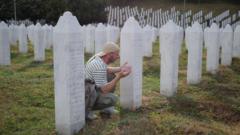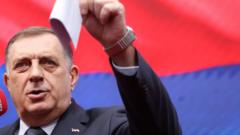In the heart of Sarajevo's War Theatre, a visceral scene unfolds, encapsulating the pain of loss that still reverberates 30 years after the Srebrenica massacre. The world premiere of "Flowers of Srebrenica" powerfully reflects the tragic events of July 1995, when Bosnian Serb forces executed a horrifying slaughter of over 8,000 Bosnian men and boys. The reminder of this grim epicenter of Europe’s darkest days brings forth both grief and unresolved societal divisions.
The Srebrenica massacre remains a poignant reminder of the war crimes committed in Bosnia, where Bosnian Serb forces overran the town, betraying the trust of those who sought sanctuary under UN protection. Instead of safety, thousands were subjected to systemic violence orchestrated by General Ratko Mladić, leading to heartbreak and the fracturing of the nation.
In the aftermath, victims' families are left to grapple with their mourning as Bone fragments often lie scattered across multiple graves, further complicating the search for closure. Many families have sought solace in Potočari Cemetery, the solemn resting place for fallen relatives after DNA testing has provided some sense of resolution.
As the audience in Sarajevo applauds the play depicting these atrocities, stark contrasts emerge across the country. While many seek truth and reconciliation, political discourse in the majority-Serb Republika Srpska continues to deny the genocide, a position incompatible with international court convictions against Mladić and his accomplices.
Lead actress Selma Alispahić, a former refugee, expresses the exhaustion of continuously validating historical truths. She laments the persistent narrative of denial that seems to protect those who orchestrated the war's violence. The resulting societal rift is deeply rooted in the Dayton Peace agreement, which partitioned Bosnia along ethnic lines into two entities, exacerbating ongoing tensions.
Recent political maneuvers, including retaliatory legislation in Republika Srpska by President Milorad Dodik, heighten fears of potential unrest. His defiance against the international High Representative’s authority mirrors the troubling patterns seen in the 1990s, stirring concerns about the safety of vulnerable communities still reeling from the past.
In Sarajevo’s streets, the anniversary of the massacre resonates with communal remembrance, underscoring hope for solidarity. Yet, just a short distance away in East Sarajevo, public observance of the tragedy is non-existent, illustrating the ongoing cultural and ethnic divide.
Despite the alarming atmosphere incited by political leaders, many remain devoted to honoring Srebrenica's victims. As cyclists and other supporters arrive to commemorate these lives lost, there is a palpable sense of unity among those insistent on not forgetting the past.
For Mirela Osmanović, who lost two brothers during the massacre, the rise in ethnic tensions is chilling. With continued manipulation of historical narrative, the road to healing remains fraught with challenges as the country grapples with its painful history and uncertain future.
The Srebrenica massacre remains a poignant reminder of the war crimes committed in Bosnia, where Bosnian Serb forces overran the town, betraying the trust of those who sought sanctuary under UN protection. Instead of safety, thousands were subjected to systemic violence orchestrated by General Ratko Mladić, leading to heartbreak and the fracturing of the nation.
In the aftermath, victims' families are left to grapple with their mourning as Bone fragments often lie scattered across multiple graves, further complicating the search for closure. Many families have sought solace in Potočari Cemetery, the solemn resting place for fallen relatives after DNA testing has provided some sense of resolution.
As the audience in Sarajevo applauds the play depicting these atrocities, stark contrasts emerge across the country. While many seek truth and reconciliation, political discourse in the majority-Serb Republika Srpska continues to deny the genocide, a position incompatible with international court convictions against Mladić and his accomplices.
Lead actress Selma Alispahić, a former refugee, expresses the exhaustion of continuously validating historical truths. She laments the persistent narrative of denial that seems to protect those who orchestrated the war's violence. The resulting societal rift is deeply rooted in the Dayton Peace agreement, which partitioned Bosnia along ethnic lines into two entities, exacerbating ongoing tensions.
Recent political maneuvers, including retaliatory legislation in Republika Srpska by President Milorad Dodik, heighten fears of potential unrest. His defiance against the international High Representative’s authority mirrors the troubling patterns seen in the 1990s, stirring concerns about the safety of vulnerable communities still reeling from the past.
In Sarajevo’s streets, the anniversary of the massacre resonates with communal remembrance, underscoring hope for solidarity. Yet, just a short distance away in East Sarajevo, public observance of the tragedy is non-existent, illustrating the ongoing cultural and ethnic divide.
Despite the alarming atmosphere incited by political leaders, many remain devoted to honoring Srebrenica's victims. As cyclists and other supporters arrive to commemorate these lives lost, there is a palpable sense of unity among those insistent on not forgetting the past.
For Mirela Osmanović, who lost two brothers during the massacre, the rise in ethnic tensions is chilling. With continued manipulation of historical narrative, the road to healing remains fraught with challenges as the country grapples with its painful history and uncertain future.






